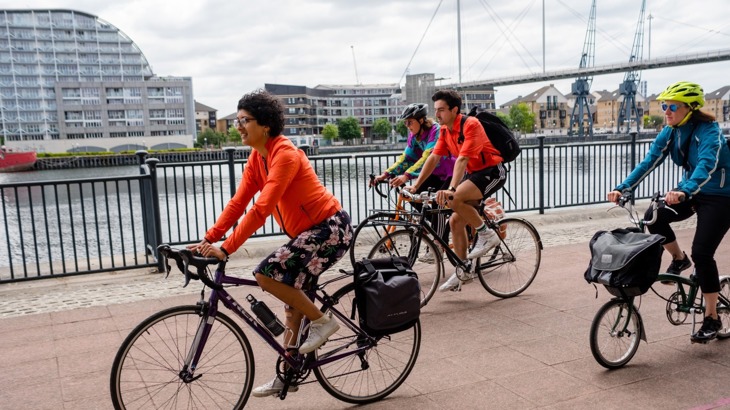Londoners working and living in the east of the capital deserve a better, quicker, cheaper and greener way of crossing the River Thames. There is a huge gap to be bridged. That is why we’re calling on the Mayoral candidates to take a strong lead and commit to a walking and cycling bridge between Rotherhithe and Canary Wharf.
Strong Mayoral leadership on bridging the gap is critical
London Mayoral elections May 2020
Make your voice heard and help get this bridge built. Contact your Mayoral candidate before they start publishing their manifestos.
- Say to them how important this is for the future of London.
- Tell them how it will improve the lives of thousands of Londoners. Remind them that it will provide an easy way of travelling across the river.
- Ask them to back the bridge.
Matt Winfield, Sustrans London Director:
“We’ve got to bridge the gap between the journeys Londoners have to put up with and the journeys they want and need.

East and west are miles apart when it comes to bridging the gap
Draw a circle around London following the M25 and travel the Thames eastward. You’ll find there are 34 different bridges that cross the Thames connecting communities. But venture out east beyond Tower Bridge and there’s only one.
This isn’t just a physical gap. It’s a gap between the cheap, clean and easy journeys Londoners want and the journeys they have.
It’s a gap between the homes London is building and the jobs it’s creating.
A gap between the lethal and illegal air we have to breathe and the clean air we want to breathe. A gap we think the Mayor should bridge.
Potential for cleaner, cheaper and more active journeys
Our 2017 feasibility study showed how a bridge would unlock thousands of journeys by foot and bike every day. This would add up to millions of active commutes each year.
There are over 7.2 million daily journeys made by foot or by cycle in London. More than 730,000 journeys are cycled every day.
A new bridge connecting Canary Wharf and Rotherhithe would be the gateway to quick, easy and healthy journeys for thousands of Londoners. It would help to clean London’s air, improve our health and make journeys across the river easier.
Opportunity and fair travel for everyone
Bridging the gap between homes and opportunities in East London would be no different from the bridges in the centre of London.
The bridge would be free of traffic, free of exhaust fumes and accessible to everyone.
That journey today is a choice between a fume-filled traffic tunnel, waiting for a ferry or a narrow and busy foot tunnel.
A new walking and cycling bridge would help transform East London by providing a vital transport link across the Thames between Rotherhithe and Canary Wharf.
Our study shows that a new bridge would support over 13,000 cycle trips each day – that’s more than 10 Jubilee Line trains packed-full of commuters.
The 30,000 people living on the Rotherhithe Peninsula would be within an easy walk of Canary Wharf, where jobs are set to double over the next decade.

A new bridge connecting Canary Wharf and Rotherhithe would be the gateway to quick, easy and healthy journeys for thousands more Londoners.
Overwhelming public support for the bridge
A massive 93% of respondents to the Transport for London consultation supported plans for a new pedestrian and cycling crossing over the Thames.
A significant 85% of respondents prefer a bridge over a ferry or tunnel. And the greatest support is for a bridge to link Nelson Dock and Westferry Circus.
The bridge’s success depends upon high-quality cycling routes linking it to Cycleway 4 in the south, Cycleway 3 in the north, and the wider network.
Due to the range of river traffic at this location, the bridge needs to open for shipping. TfL has carried out an analysis on what type of design would be suitable.
Here’s what we supported following the TfL consultation
- We support a navigable bridge for walking and cycling, designed as the main route between Canary Wharf and Rotherhithe
- We support the central or northern alignments
- We believe a lower crossing is preferable for walking and cycling
- We believe the bridge’s success depends on connections to high-quality cycling routes
Funding the bridge
This state of the art bridge would be car-free, pollution-free, and free for all to use.
But it has been paused at the moment due to costs.
We know that there are several ways to fund the bridge.
There is also a discussion to be had about changing the way the river is used. This would remove the need for a bridge that has to open and significantly lower the design and building costs.
Quicker, easier and healthier commutes benefit London’s economy.
Our study estimated the value of saved time to London’s economy at £10 million per year. That’s without counting the major health benefits as well.





